How to park with predictive course lines
WARNING
• Always turn and check that it is safe to park your car before backing up.
Always back up slowly.
• Use the displayed lines as a reference.
The lines are highly affected
by the number of occupants, fuel
level, vehicle position, road condition
and road grade.
• If the tires are replaced with different
sized tires, the predictive course
line may not be displayed correctly.
• On a snow-covered or slippery road,
there may be a difference between
the predictive course line and the
actual course line.
• If the battery is disconnected or
becomes discharged, the predictive
course lines may not be displayed
correctly. If this occurs, perform the
following procedures.
— Drive the vehicle on a straight road for more than 5 minutes.
• When the steering wheel is turned
with the ignition switch in the “ACC”
position, the predictive course lines
may not be displayed correctly.
• The displayed lines will appear
slightly off to the right because the
RearView camera is not installed in
the rear center of the vehicle.
• The distance guide line and the
vehicle width guide line should be
used as a reference only when the
vehicle is on a level paved surface.
The distance viewed on the monitor
is for reference only and may be
different than the actual distance
between the vehicle and displayed
objects.
• When backing up the vehicle up a
hill, objects viewed in the monitor
are further than they appear. When
backing up the vehicle down a hill,
objects viewed in the monitor are
closer than they appear. Use the
inside mirror or glance over your
shoulder to properly judge distances
to other objects.
The vehicle width and predictive course lines are wider than the actual width and course.
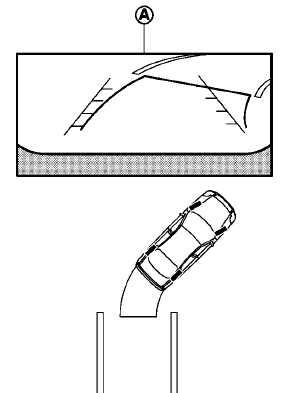
1. Visually check that the parking space is safe
before parking your vehicle.
2. The rear view of the vehicle is displayed on
the screen A as illustrated when the shift
lever is moved to the R (Reverse) position.
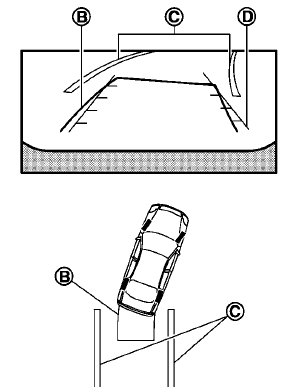
3. Slowly back up the vehicle adjusting the
steering wheel so that the predictive course
lines B enter the parking space C .
4. Maneuver the steering wheel to make the
vehicle width guide lines D parallel to the
parking space C while referring to the
predictive course lines.
5. When the vehicle is parked in the space
completely, move the shift lever to the P
(Park) position and apply the parking brake.
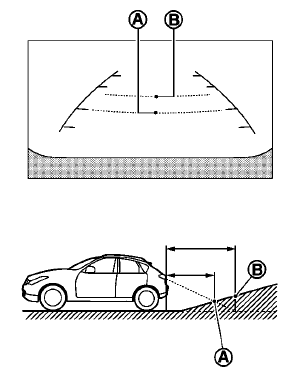
Difference between predictive and actual distances
Backing up on a steep uphill:
When backing up the vehicle up a hill, the distance guide lines and the vehicle width guide lines are shown closer than the actual distance.
For example, the display shows 3 ft (1 m) to the place A , but the actual 3 ft (1 m) distance on the hill is the place B . Note that any object on the hill is viewed in the monitor further than it appears.
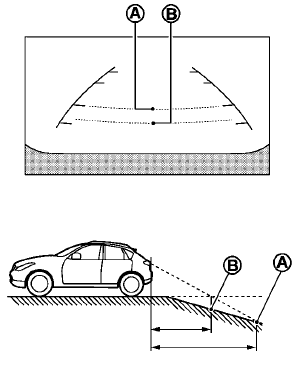
Backing up on a steep downhill:
When backing up the vehicle down a hill, the distance guide lines and the vehicle width guide lines are shown further than the actual distance.
For example, the display shows 3 ft (1 m) to the place A , but the actual 3 ft (1 m) distance on the hill is the place B . Note that any object on the hill is viewed in the monitor closer than it appears.
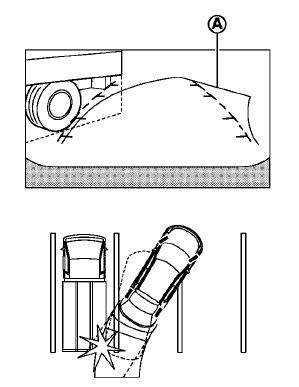
Backing up near a projecting object:
The predictive course lines A do not touch the object in the display. However, the vehicle may hit the object if it projects over the actual backing up course
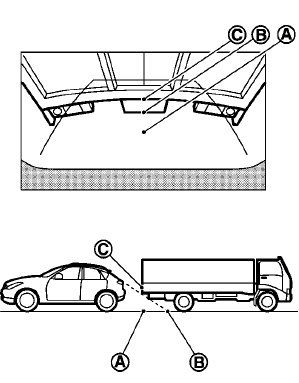
Backing up behind a projecting object:
The position C is shown further than the position B in the display. However, the position C is actually at the same distance as the position A . The vehicle may hit the object when backing up to the position A if the object projects over the actual backing up course.
See also:
When operating the top
WARNING
Keep hands and other parts of the body
away from moving parts such as the
top, storage lid, inner flap A and
power windows.
CAUTION
• Keep all parts of the top linkage
clear ...
NISSAN voice recognition Alternate Command Mode
The following section is applicable when Alternate
Command Mode is activated.
When Alternate Command Mode is activated,
an expanded list of commands can be used after
pressing the TALK switch. I ...
Emergency tire puncture repair kit (if so equipped)
The emergency tire puncture repair kit (Emergency
Tire Sealant) is supplied with the vehicle
instead of a spare tire. It can be used to
temporarily repair minor tire punctures.
If possible, have ...
